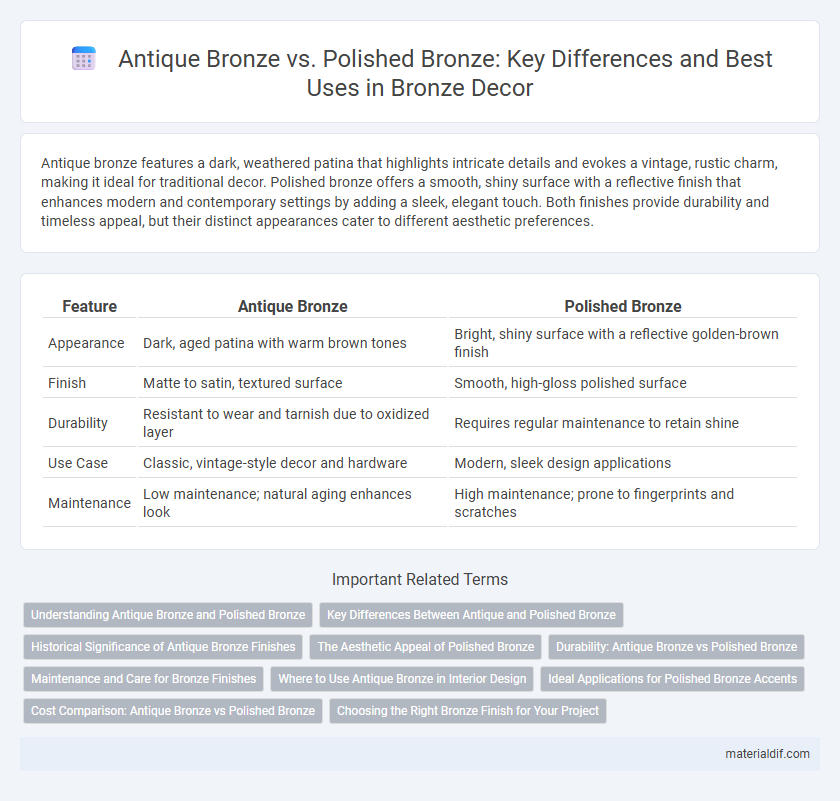Antique bronze features a dark, weathered patina that highlights intricate details and evokes a vintage, rustic charm, making it ideal for traditional decor. Polished bronze offers a smooth, shiny surface with a reflective finish that enhances modern and contemporary settings by adding a sleek, elegant touch. Both finishes provide durability and timeless appeal, but their distinct appearances cater to different aesthetic preferences.
Table of Comparison
| Feature | Antique Bronze | Polished Bronze |
|---|---|---|
| Appearance | Dark, aged patina with warm brown tones | Bright, shiny surface with a reflective golden-brown finish |
| Finish | Matte to satin, textured surface | Smooth, high-gloss polished surface |
| Durability | Resistant to wear and tarnish due to oxidized layer | Requires regular maintenance to retain shine |
| Use Case | Classic, vintage-style decor and hardware | Modern, sleek design applications |
| Maintenance | Low maintenance; natural aging enhances look | High maintenance; prone to fingerprints and scratches |
Understanding Antique Bronze and Polished Bronze
Antique bronze features a rich, dark patina that develops naturally over time, enhancing its vintage aesthetic, while polished bronze is characterized by a smooth, reflective surface achieved through meticulous buffing and sealing. Understanding the key differences involves recognizing antique bronze's emphasis on aged texture and depth versus polished bronze's focus on brightness and modern appeal. Both finishes provide unique visual qualities suited for different design preferences in metalwork and decor.
Key Differences Between Antique and Polished Bronze
Antique bronze exhibits a darker, aged patina with rich brown and green hues due to oxidation, enhancing its rustic and vintage appeal. Polished bronze features a smooth, reflective surface with a bright, golden shine achieved through buffing and coating, emphasizing a modern and sleek appearance. The key differences lie in surface treatment and color tone, where antique bronze emphasizes texture and depth, while polished bronze prioritizes brightness and smoothness.
Historical Significance of Antique Bronze Finishes
Antique bronze finishes preserve the rich patina and textures developed over centuries, reflecting the historical craftsmanship and artistic techniques used since ancient times. These finishes often evoke a sense of heritage and authenticity, making them highly valued in restoration projects and period-style decor. Polished bronze, by contrast, offers a modern, shiny appearance without the depth of historical character inherent in antique bronze.
The Aesthetic Appeal of Polished Bronze
Polished bronze exhibits a lustrous and reflective surface that enhances its aesthetic appeal compared to antique bronze, which has a darker, patinated finish. The smooth, shining quality of polished bronze accentuates intricate details and provides a modern, elegant look suitable for contemporary decor. This bright, glossy finish also emphasizes the material's durability and timeless beauty, making it a popular choice for decorative art, furniture accents, and architectural elements.
Durability: Antique Bronze vs Polished Bronze
Antique bronze features a patinated surface that offers enhanced resistance to corrosion and wear, making it highly durable for outdoor and high-use applications. Polished bronze, with its smooth, glossy finish, is more susceptible to scratches and oxidation, requiring regular maintenance to preserve its appearance. The inherent durability of antique bronze's aged finish often surpasses polished bronze in longevity under harsh conditions.
Maintenance and Care for Bronze Finishes
Antique bronze displays a natural patina that requires gentle cleaning with mild soap and water to preserve its aged appearance, avoiding abrasive materials that can damage its finish. Polished bronze demands regular polishing with a brass or bronze-specific cleaner to maintain its glossy, reflective surface and prevent tarnishing. Proper maintenance of both finishes involves drying thoroughly after cleaning to inhibit moisture-related corrosion and using protective wax coatings to extend the lifespan of the bronze finish.
Where to Use Antique Bronze in Interior Design
Antique bronze, with its warm, aged patina, is ideal for creating vintage or rustic aesthetics in interior design, enhancing spaces like living rooms, kitchens, and entryways with a timeless appeal. Fixtures such as door handles, light fittings, and cabinet pulls made from antique bronze add character and depth, complementing wood and earth-toned decor elements. Its durable finish also suits high-traffic areas, providing both functionality and a classic, sophisticated look.
Ideal Applications for Polished Bronze Accents
Polished bronze accents are ideal for decorative elements in interior design, such as door hardware, light fixtures, and furniture embellishments, where a smooth, reflective finish enhances elegance and sophistication. These accents resist tarnishing and develop a warm, lustrous patina over time, making them suitable for both modern and classical aesthetics. Their durability and corrosion resistance also make polished bronze perfect for architectural details in high-traffic areas.
Cost Comparison: Antique Bronze vs Polished Bronze
Antique bronze typically costs more than polished bronze due to its intricate aging process and unique patina that enhances its vintage appeal. Polished bronze, known for its smooth, reflective surface, is generally less expensive as it requires less processing and maintenance. The price difference is influenced by the material's finish quality, with antique bronze often preferred in high-end restoration and decorative projects where cost reflects craftsmanship.
Choosing the Right Bronze Finish for Your Project
Antique bronze offers a warm, rustic patina with aged textures that highlight historic charm, ideal for vintage-inspired or traditional designs. Polished bronze features a smooth, reflective surface with a rich golden-brown tone, perfect for modern or elegant aesthetics requiring a sleek finish. Selecting the right bronze finish hinges on your project's style, intended ambiance, and maintenance preferences, ensuring the material complements the overall design vision.
Antique Bronze vs Polished Bronze Infographic

 materialdif.com
materialdif.com